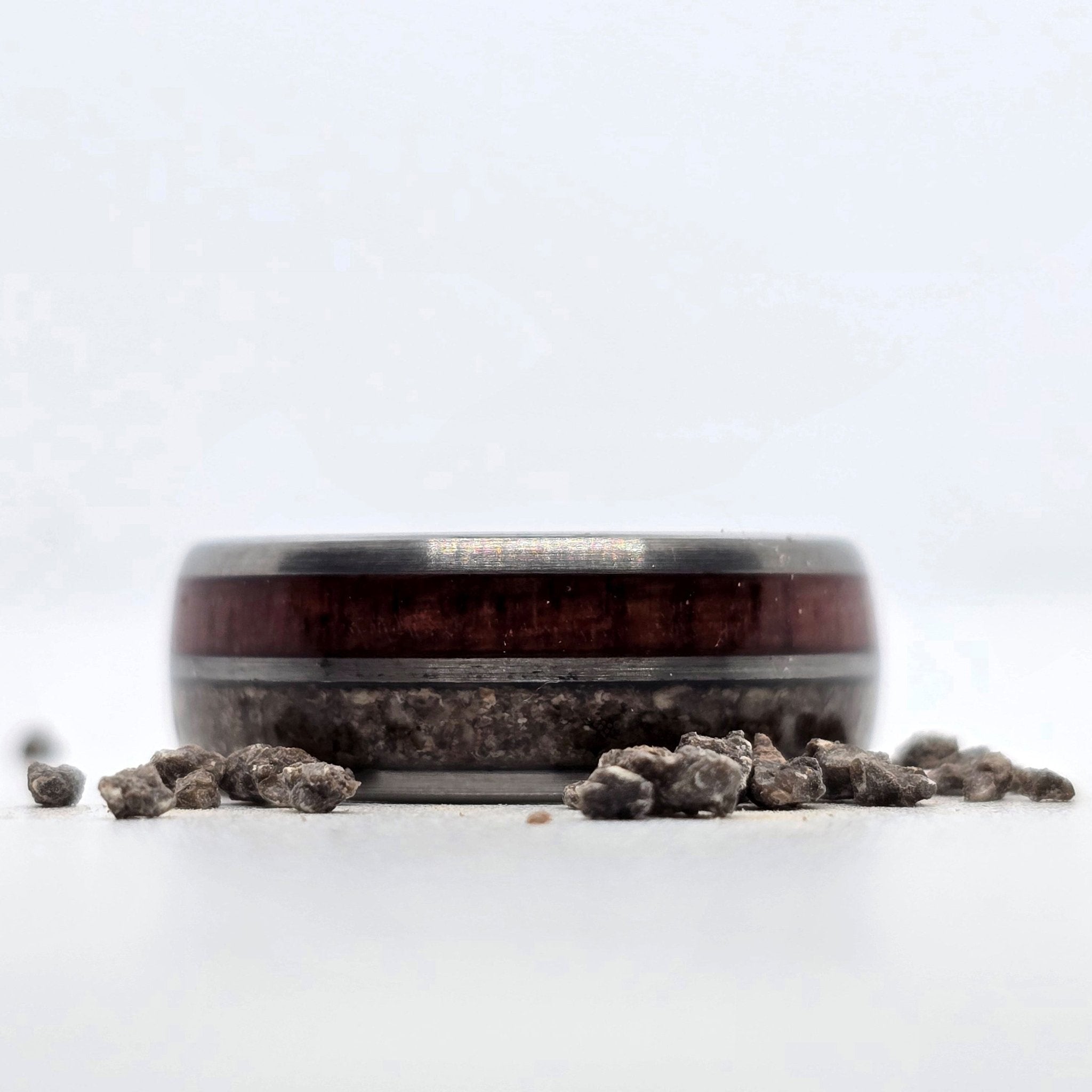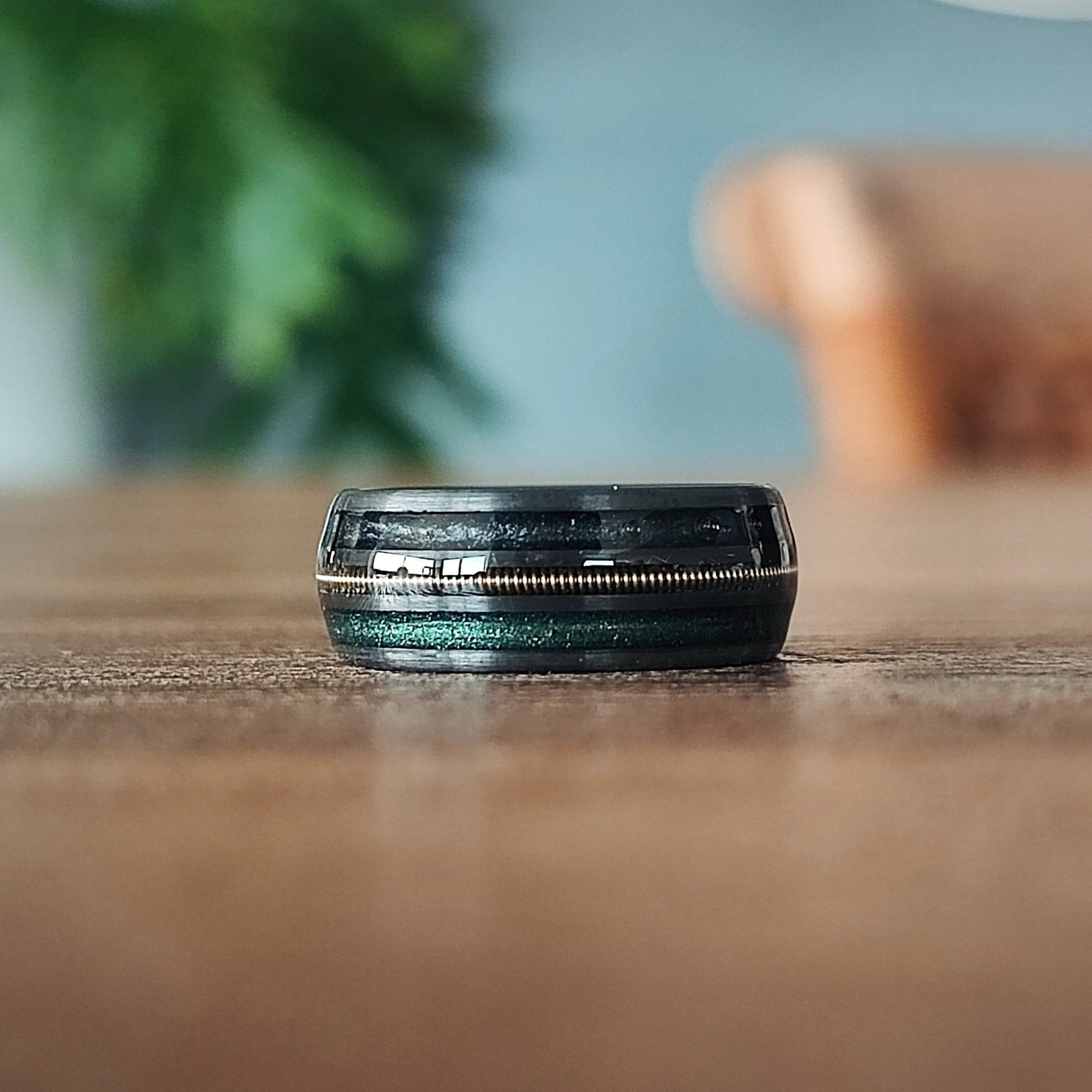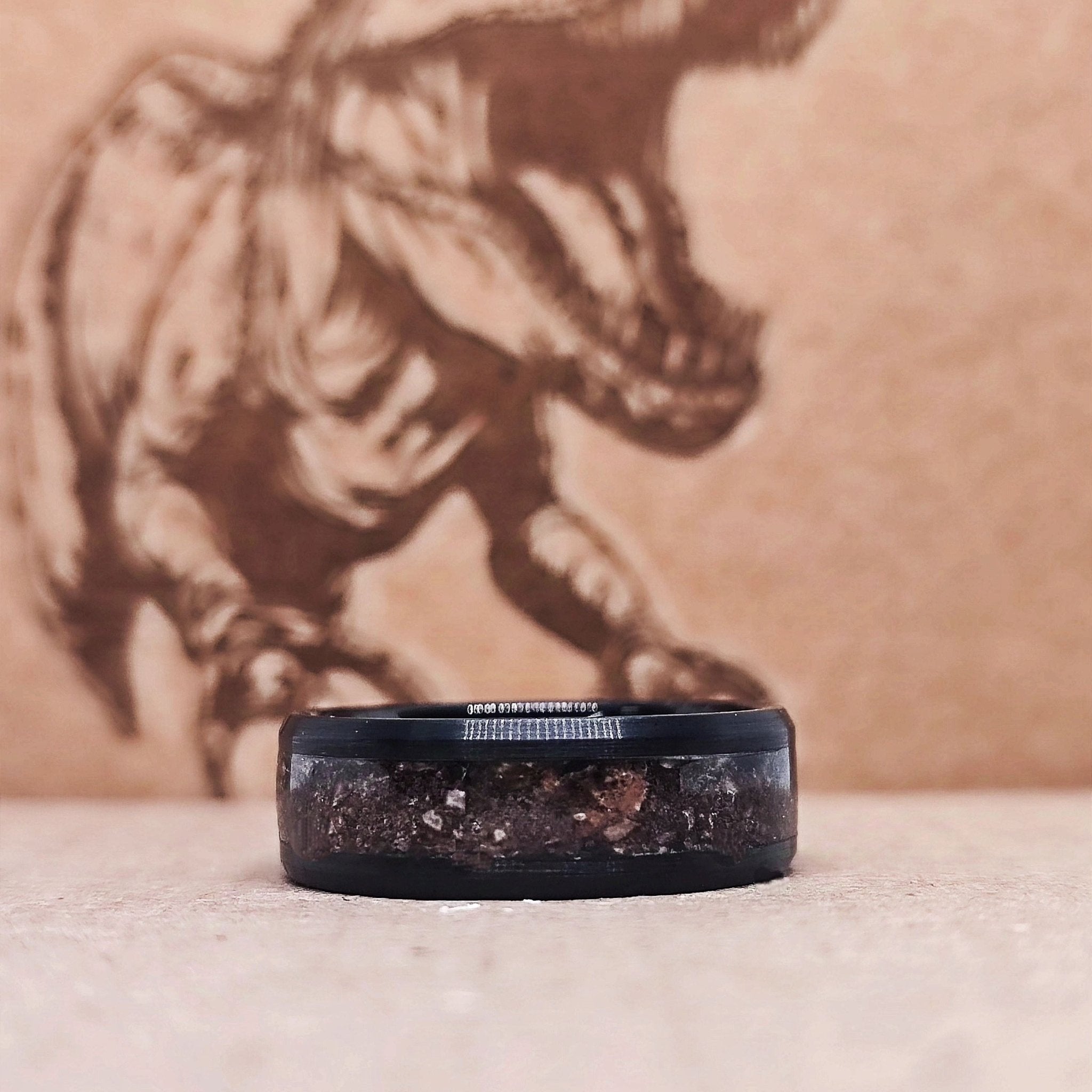
The Iron Claw – Dinosaur Bone and Rosewood (Limited Edition)
Introduction
Imagine wearing 160 million years of Earth’s history on your finger. That’s the promise of The Iron Claw — a striking limited-edition ring crafted from agatized dinosaur bone, rosewood, and brushed gunmetal tungsten. Each element of this piece tells a story: the fossilized remains of a sauropod from the Jurassic period, the rich warmth of exotic rosewood, and the industrial strength of tungsten carbide.
This extraordinary combination of materials bridges past and present, giving wearers more than just a piece of jewelry — it offers them a tangible connection to prehistory, artistry, and individuality. With only 20 rings crafted from this rare source of fossilized bone, The Iron Claw is as much a collectible treasure as it is a bold fashion statement, making it a standout choice for those seeking custom rings online.
In this blog, we’ll explore the geological origins of its materials, the design and craftsmanship behind the ring, the meaning it holds, and practical advice for care and purchase. Whether you’re a collector, a lover of natural history, or someone seeking a meaningful and distinctive piece of jewelry, this is a journey worth taking.
1. Geological & Historical Origins of the Dinosaur Bone
The centerpiece of The Iron Claw is agatized dinosaur bone, also known as “gem bone” or “dinogem.” This material originates when the cellular structure of ancient bone is slowly replaced by silica and other minerals during the fossilization process, preserving the intricate internal patterns in vibrant colors. Over millions of years, water rich in quartz infiltrates the porous bone, crystallizing and hardening it into stone. The result is a gemstone that reveals the microscopic honeycomb or cell-like structures once part of a living creature.
The specific source of the dinosaur bone used in The Iron Claw is Bouarfa, Morocco — a region known for yielding fossil material from the Jurassic period, around 160 million years ago. Paleontologists believe the fossilized remains likely belonged to sauropods, the massive, long-necked herbivores that were among the largest land animals to ever walk the Earth.
Rings made from agatized dinosaur bone are rare, but sourcing material from Morocco adds to their uniqueness. Fossil deposits are finite, and only a fraction contain agatized specimens with gemstone quality. For collectors, owning such a ring means holding a tangible fragment of deep time, preserved in wearable form.
2. Rosewood: A Natural Companion in the Inlay
On the other side of the ring’s inlay lies rosewood, chosen for both its durability and aesthetic appeal. Rosewood refers to a group of richly hued timbers known for their dark red to purplish coloration and striking grain patterns. Traditionally used in fine furniture, instruments, and luxury accessories, rosewood is prized for its balance of strength and beauty.
In jewelry, rosewood brings warmth that contrasts beautifully against the cool, mineral nature of fossil stone. Where agatized dinosaur bone tells a story of prehistoric life, rosewood offers a living counterpart — an organic material whose grain and depth provide softness and harmony. The combination balances rugged history with natural elegance.
Using wood in rings does require attention. Unlike metals, wood is sensitive to moisture and temperature changes. That’s why in The Iron Claw, rosewood is protected by a durable epoxy seal that waterproofs the inlay and prevents warping. The result is a ring that retains the authentic appeal of wood while being practical for long-term wear.
Together, dinosaur bone and rosewood create a striking contrast of earth’s history and nature’s artistry — a harmony that makes The Iron Claw a wearable work of art.
3. The Tungsten Gunmetal Band: Material & Finish
The foundation of The Iron Claw is its brushed gunmetal tungsten band, chosen for strength, resilience, and sleek appearance. Tungsten carbide is renowned for being one of the hardest materials used in jewelry — second only to diamond in scratch resistance. This makes it an ideal choice for a ring meant to endure daily wear without losing its polish.
The brushed gunmetal finish offers a modern, masculine aesthetic. Unlike polished tungsten, which reflects light brightly, brushed tungsten provides a matte look that minimizes glare while highlighting the textures of the inlays. Gunmetal’s dark gray tone also serves as a perfect backdrop to accentuate the colorful agatized bone and warm rosewood.
The band is designed with a comfort-fit dome shape, meaning the inner edges are slightly rounded. This design distributes pressure evenly across the finger, making the 8mm width surprisingly easy to wear. Tungsten’s weight adds to the substantial feel, reminding the wearer that this is not just jewelry but a piece with presence and gravitas.
Practicality and design meet here: the tungsten ensures durability, the brushed texture ensures elegance, and the comfort-fit ensures wearability — qualities that anchor the ring’s prehistoric and organic elements securely.
4. Design Features & Specifications of The Iron Claw
What sets The Iron Claw apart is its meticulous design. The ring features dual inlays: a 2.5mm strip of agatized dinosaur bone on one side and a 2.5mm strip of rosewood on the other. This balanced placement creates a mirror effect — history on one side, natural beauty on the other.
At 8mm wide, the band makes a bold statement, particularly with its dome profile. The brushed gunmetal tungsten adds depth without overwhelming the design. The protective epoxy seals both inlays, ensuring they remain waterproof and resistant to everyday wear. Unlike untreated fossil or wood rings, this epoxy finish means the piece is built for longevity.
Another defining element is exclusivity. Only 20 rings can be made from this specific fossil material. Once that supply is gone, no more can be created, making The Iron Claw a limited edition collectible. Each ring is slightly unique in its fossil cell patterns and wood grain, ensuring no two are identical.
This fusion of materials and thoughtful design demonstrates the artistry of modern jewelry makers. The ring isn’t simply functional — it is crafted to highlight history, nature, and style in equal measure.
5. Craftsmanship: From Raw Fossil to Finished Ring
Transforming dinosaur bone into a polished inlay is no small task. The process begins with stabilizing the raw fossil. Because agatized bone can be brittle, artisans often impregnate it with resins to strengthen the structure before cutting. Using precision saws, they slice the fossil into small sections, carefully orienting them to maximize the visibility of the cell structure.
Polishing follows, where lapidary tools bring out the fossil’s vivid colors and intricate honeycomb patterns. Rosewood undergoes a parallel preparation: dried, cut, and shaped into strips to fit precisely within the tungsten channel.
The inlay process is meticulous. Each strip of fossil and wood is secured into the tungsten band, then sealed with epoxy to prevent moisture intrusion. The epoxy is carefully leveled and cured, forming a protective, glass-like surface that keeps the materials safe while enhancing their natural beauty.
Finally, the band is finished with its brushed texture, ensuring the fossil and wood inlays transition seamlessly into the tungsten. Every step requires precision, as even minor imperfections can compromise the ring’s comfort or durability. The result is a piece that exemplifies both engineering precision and artistic craftsmanship.
6. Symbolism & Meaning: Why Wear Something So Ancient?
Jewelry often carries meaning beyond aesthetics, and The Iron Claw is no exception. At its core, the ring symbolizes continuity — a link between the ancient past and the present. Wearing agatized dinosaur bone is a reminder of Earth’s evolutionary history, survival, and resilience.
For some, the symbolism is deeply personal. The dinosaur bone may represent strength, endurance, or transformation, while rosewood brings associations of warmth, love, and growth. Together, they can serve as a metaphor for balance: the enduring past paired with the vitality of life.
There’s also the appeal of rarity. In a world of mass-produced jewelry, owning a piece made from fossilized remains is a statement of individuality. Like meteorite rings or fossil shark tooth pendants, The Iron Claw stands apart by connecting its wearer to the grandeur of nature and the passage of time.
This symbolic weight makes the ring not just a fashion accessory but a conversation piece — one that sparks curiosity and reflection every time it’s worn.
7. Who Is The Iron Claw Ring For?
While The Iron Claw appeals to anyone who appreciates unique jewelry, its design particularly resonates with certain groups. Collectors of natural history or paleontology enthusiasts will value the chance to wear a fossil that connects them to the Jurassic era. For adventurers and outdoorsmen, the rugged blend of fossil, wood, and tungsten reflects a lifestyle rooted in exploration.
Fashion-wise, the ring complements both rugged and modern minimalist wardrobes. Its wide band and dark tones make it a bold accessory for casual wear, while the polished inlays allow it to pair with formal attire for someone who wants to stand out.
It also makes for a meaningful gift. Anniversaries, birthdays, or milestone occasions are perfect opportunities to present a ring that literally carries history. Because of its limited edition nature, gifting The Iron Claw shows thoughtfulness and exclusivity, making the recipient feel truly special.
Ultimately, this ring is for those who want jewelry that tells a story — individuals who seek both style and substance.
8. Care, Maintenance & Longevity
Despite its durability, The Iron Claw requires mindful care to maintain its brilliance. The tungsten band is virtually scratch-resistant, but the inlays, though sealed, benefit from gentle handling. Avoid exposing the ring to harsh chemicals such as bleach or chlorine, which can damage the epoxy seal.
Cleaning is simple: use a soft cloth with mild soap and warm water, then dry thoroughly. Avoid ultrasonic cleaners, as vibrations can stress the epoxy or inlays. For long-term storage, keep the ring in a dry case to prevent unnecessary exposure to humidity.
When engaging in high-impact activities such as weightlifting or rock climbing, consider removing the ring. While tungsten is incredibly strong, it can be brittle under extreme force. Protecting the fossil and wood inlays from sudden impacts will ensure the ring lasts for decades.
With proper care, The Iron Claw offers lasting beauty. Its protective epoxy, durable tungsten, and stabilized materials mean it’s built not just to look stunning today, but to be a heirloom that can be passed down.
9. Price, Value & Limited Edition Rarity
The value of The Iron Claw lies not only in its materials but in its rarity. Only 20 rings can be produced from this specific source of fossilized bone, making each piece inherently collectible. Once these are sold, they cannot be replicated, adding exclusivity to the investment.
Comparatively, standard tungsten or wood-inlay rings are far more common and often mass-produced. While they may be less expensive, they lack the depth of meaning and rarity that a fossil ring provides. For collectors, this scarcity significantly enhances the perceived value.
Price also reflects the craftsmanship required to work with fossil and wood, both of which demand precision and skill. Lead times of 3–5 extra working days for custom creation underline the level of care that goes into each piece.
Beyond monetary worth, value here is emotional and symbolic. Owning a piece that combines geological history with modern artistry is an experience few can claim — making the investment worthwhile.
10. How to Choose the Right Size & Avoid Common Mistakes
Because The Iron Claw is custom made, getting the size right is crucial. Unlike standard rings, comfort-fit bands have slightly different sizing, often feeling looser than flat-fit bands. Measuring your finger with a professional ring sizer is the best way to ensure accuracy. Remember that wider bands, such as this 8mm ring, can feel tighter than narrower bands.
A common mistake is assuming inlay materials are indestructible. While tungsten is nearly scratchproof, wood and fossil inlays require protection. Avoid prolonged exposure to water and physical impact. The epoxy seal helps, but carelessness can shorten the ring’s life.
Customers should also be aware of exchange policies. Because of the ring’s custom nature, exchanges are only offered at 50% of the selling price. Confirming size before ordering prevents disappointment and additional cost.
Finally, plan ahead. Each ring takes 3–5 extra working days beyond normal lead times. If purchasing as a gift, order early to ensure timely delivery. Thoughtful preparation ensures a smooth buying experience and long-lasting satisfaction with your piece.
Conclusion
The Iron Claw – Dinosaur Bone & Rosewood is more than a ring. It is a wearable fragment of Earth’s history, a symbol of endurance and individuality, and a showcase of modern craftsmanship. By combining agatized dinosaur bone from Morocco’s Jurassic deposits, the warmth of rosewood, and the strength of brushed gunmetal tungsten, this piece embodies the perfect union of history, nature, and design.
Its limited availability — just 20 rings worldwide — makes it an exceptional collectible. Every time you wear it, you’re not simply accessorizing; you’re carrying a story that spans millions of years.
For those seeking jewelry with meaning, rarity, and bold style, The Iron Claw offers a rare opportunity. Confirm your size, care for it wisely, and you’ll have not only a ring but a timeless piece of history on your hand.



